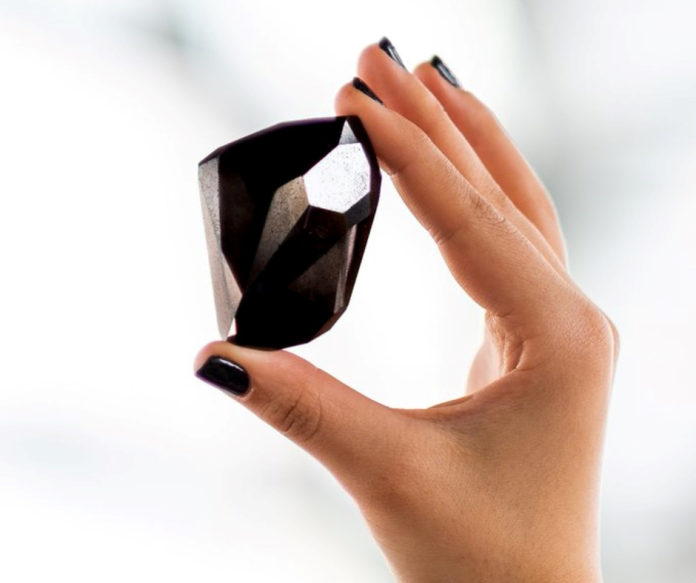
Black diamonds contradict the classic image of a diamond as a colorless, transparent gem, but black diamonds do exist and they are currently attracting considerable attention.
Black diamond refers to both carbonado diamonds and black gem diamonds, they are not a diamond alternative and they are not synthetic diamonds. Carbonado, a rare type of diamond with a polycrystalline structure, is not normally considered a gemstone. Nevertheless, super large diamonds like large, faceted carbonados sell for several million dollars. Black gem diamonds, on the other hand, are a color variety of monocrystalline, or “single-crystal,” diamonds—the familiar stones we see in jewelry stores.
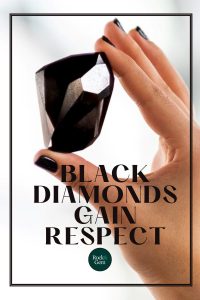
Carbonado Black Diamonds
In 1843, Brazilian placer miners discovered dense, opaque, black pebbles and cobbles that they named “carbonado,” after the Portuguese carbonizado, meaning “carbonized” or “burned” and alluding to their charred appearance. Mineralogists subsequently described carbonado as a previously unknown form of diamond with a polycrystalline structure and consisting of tightly bonded aggregates of randomly arranged diamond microcrystals.
Carbonado had no value until the 1870 introduction of diamond-studded drill bits. With its greater hardness and durability, along with a microcrystalline structure that provided more cutting edges, carbonado’s rock-cutting ability far exceeded that of a monocrystalline diamond.
Industrial demand for carbonado soared and, by 1880, Brazil was mining 70,000 carats (30.9 pounds) per year and selling it to the United States and Europe for $20 per carat. Carbonado-studded drill bits were later used extensively in building the Panama Canal and developing Minnesota’s great open-pit iron mines. Carbonado has now been replaced by synthetic polycrystalline diamond and is no longer mined commercially
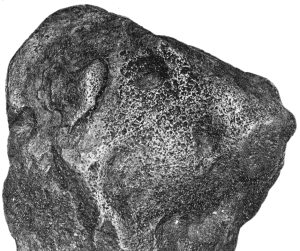
Courtesy Wikimedia Commons
The Great Carbonados
Carbonado diamonds are quite rare. Only an estimated three tons have been mined in the past 150 years—almost nothing compared with the 25 tons of monocrystalline diamonds now mined worldwide each year. Despite its scarcity, carbonado has provided many extraordinary specimens.
In 1895, Brazilian placer miner Sérgio Borges de Carvalho recovered a huge carbonado of 3,167 carats (22.34 ounces). Weighing 61 carats more than South Africa’s fabled Cullinan Diamond (monocrystalline), it was the largest diamond of any kind ever found. The “Sérgio Diamond,” named in de Carvalho’s honor, sold for $16,000 ($500,000 in 2023 dollars). Unfortunately, it was broken up into cutting studs for drill bits.
Of the few gems ever cut from Carbonado, the most spectacular is the Enigma Diamond. The world’s largest faceted diamond, the Enigma sold in 2022 in a highly publicized auction for $4.3 million. The preponderance of “fives” in this irregularly cut, 55-facet, 555.55-carat gem is not coincidental: Its previous owner, an Arab tycoon, styled its cut after the ancient Mideastern hamsa amulet, which both Jewish and Arabic traditions associate with the number five.
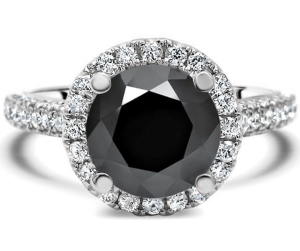
Courtesy Wikimedia Commons
The Origin of Carbonado
Scientists initially assumed that both polycrystalline and monocrystalline diamonds formed in the extreme heat and pressure of the Earth’s mantle and were later emplaced in surface kimberlite pipes. But carbonado does not occur in association with monocrystalline diamonds.
By the 1970s, researchers had concluded that carbonado’s unusual inclusions indicated not mantle formation, but rather meteoric origin. They also noted that because carbonado in quantity was found only in Bahia, Brazil, and the Ubangi River region of the Central African Republic—and in the same geologic horizons—it had likely fallen to Earth in a single, massive meteoric event when South America and Africa were joined as one landmass.
Many scientists now believe that carbonado formed on exploding red giants (large stars with low surface temperatures) when shock waves compressed carbon into polycrystalline diamonds before hurling it into space where some eventually reached Earth as meteorites.
Black Diamonds
Meanwhile, as scientists continued to debate the origin of carbonado, black monocrystalline diamonds were gaining popularity as faceted gems. Their black color and opacity are caused by numerous tiny inclusions, most often of graphite or amorphous carbon.
Only about 1 in 10,000 monocrystalline diamonds is naturally black. Historically, these stones had no gem value until the 1990s when they began appearing in white gold and platinum settings accompanied by colorless melee diamonds. These black monocrystalline diamonds also began attracting metaphysical interest as stones that provide wearers with power, determination, and inner strength.
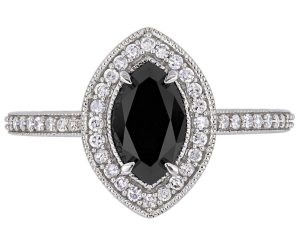
Courtesy Wikimedia Commons
Natural vs. Treated
Faceted, natural, black monocrystalline diamonds now sell for about $2,500 per carat. But most black-diamond gems currently being sold started as heavily included, grayish, industrial-grade diamonds. Heating these low-value stones to 1300°C for several hours converts tiny inclusions of amorphous carbon to graphite which absorbs white light and produces nearly opaque, very dark green stones that appear black. Today, loose, heat-treated, faceted black diamonds sell for roughly $300 per carat.
The most celebrated natural, black, monocrystalline diamond gem is the 67.5-carat Black Orlov Diamond. Mined as a 195-carat rough crystal, it was believed to be cursed after three of its owners committed suicide. To break the curse, the gem was cut into three pieces, the largest being the Black Orlov. Mounted in a brooch and surrounded by a circle of 108 small, colorless diamonds, the Black Orlov has been displayed at major museums around the world.
So, whether as polycrystalline carbonado or monocrystalline gems, black diamonds are finally gaining the respect they deserve.
This story about black diamonds previously appeared in Rock & Gem magazine. Click here to subscribe. Story by Steve Voynick.















